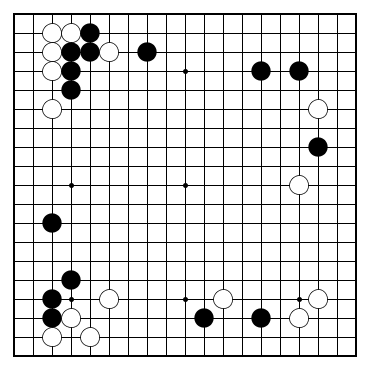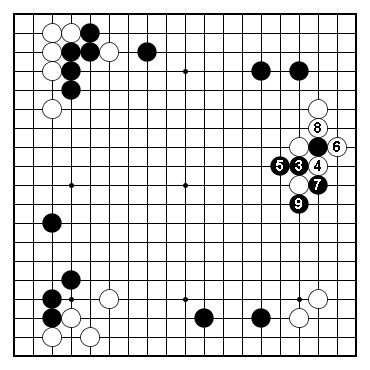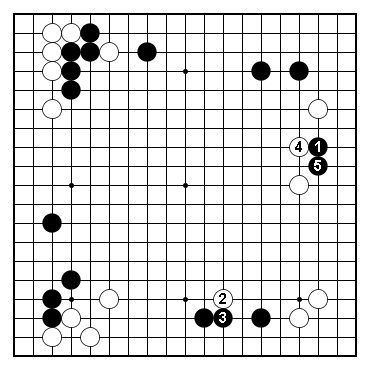Forcing Moves, and an Eye For an Eye
This is about how to handle forcing moves: sometimes we have no choice but to answer them patiently. But there are times when we are better off retaliating. What if we can ignore the opponent's "forcing" move and take profit somewhere else?
Black to play in Dia. 1.
Many of you will recognize two "hot" areas in Dia. 1. Which one is more important, and how to play?
 Dia. 1
Dia. 1
Let's start with a bit of background story. When Black invades with 1 in Dia. 2, White's standard move is to attach above, with 2. Next, Black can continue with A or B.
A is pretty slow - Black is living small on the side, and White is developing a strong wall in the center.
Unless there are "special circumstances" (such as Black is ahead and he can afford to play slowly, or White's wall is not effective), Black wants to play the more active continuation at B.
 Dia. 2
Dia. 2
Dia. 3 shows one way for White to continue: he can let Black live on the side.
Black has nothing to complain in this diagram: he is living very comfortable on the side, while White's position on the outside has cutting points at A and B. Black's active move at 3 paid off.
 Dia. 3
Dia. 3
If White is not satisfied with Dia. 3 - and he certainly has no reason to be in this game - he'll respond to Black 3 with 4 in Dia. 4.
This is a pretty standard sequence. In case you are not familiar with it, 2 ladders are involved here. After Black 5 in Dia. 4, White can either capture with 6, or connect at 7. Whichever side White chooses to play, Black has the option to capture one stone (depending on a ladder) on the other side. In this game, both ladders are good for Black. White can do something about that, though...
 Dia. 4
Dia. 4
White can play a ladder-breaker at 2 in Dia. 5. After Black responds at 3, White returns to 4 as usual.
Black cannot play as in Dia. 4 anymore now - or else the ladder he starts with 9 in Dia. 4 would be in White's favour this time.
So Black has no choice but to play the passive extension at 5 in Dia. 5. Or has he?
 Dia. 5
Dia. 5
In this case, Black is better off not responding White's forcing move, but retaliating: "an eye for an eye".
Black can exchange 3 for 4 in Dia. 6, then jump out at 5 to continue the damage he started with the invasion on the right. White has to play at 6 in order to make sense of his forcing move at 2, but Black will continue by playing at 7, which looks great: it both expands Black's position into the center, and it reduces White's position in the lower right.
By the way, the exchange of 3 for 4 was meant to make those stones hard to capture in one move.
 Dia. 6
Dia. 6
Conclusion
- You don't always have to answer what the opponent thinks it is a forcing move - if you can take larger profit somewhere else, go for it.
